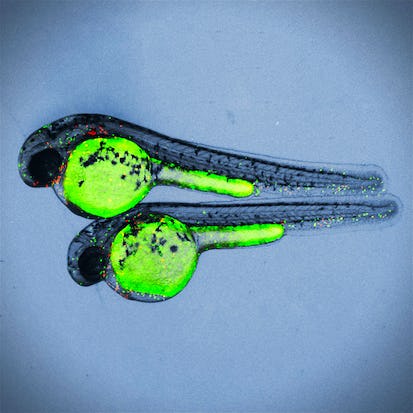- Level Professional
- Duration 21 hours
- Course by University of Geneva
-
Offered by

About
Chemical biology is a burgeoning field that has rapidly risen to prominence. This surge of interest has been fuelled by chemical biology's applicability to understanding critical processes in live cells or model organisms in real time. This success has arisen because chemical biology straddles a nexus between chemistry, biology, and physics. Thus, chemical biology can harness rapid chemistry to observe or perturb biological processes, that are in turn reported using physical assays, all in an otherwise unperturbed living entity. Although its boundaries are endless, the multidisciplinary nature of chemical biology can make the field seem daunting; we beg to differ! Here, we deconstruct chemical biology into its core components, and repackage the material. In the process we build up for each student a practical and theoretical knowledge bank that will set these students on their way to understanding and designing their own chemical biology experiments. We will discuss fluorescence as a general language used to read out biological phenomena as diverse as protein localization, membrane tension, surface phenomena, and enzyme activity. We will proceed to discuss protein labeling strategies and fusion protein design. Then we will discuss larger and larger scale chemical biology mechanism and screening efforts. Highlights include a large amount of new data, tailored in the lab videos, and a large number of skilled presenters.Modules
The boundless trajectories of chemical biology
4
Videos
- Trailer
- Welcome
- Why study chemical biology?
- Course outline and highlights
2
Readings
- Course Acknowledgements
- 📢 Important preliminary information: Evaluations and subtitles
Chemical Biology - Concepts 1
1
Assignment
- Components of a cell
1
Videos
- The building blocks: monomeric units of proteins
2
Readings
- The foundation: the cell
- The workhorses: proteins, enzymes
Chemical Biology - Concepts 2
1
Assignment
- Amino acids
2
Videos
- The building blocks: monomeric units of DNA and membranes
- Messengers and messages: posttranslational modifications, and pathways
An eye opener; visualizing biomolecules
1
Assignment
- Match technique to goal
1
Videos
- Studying cellular processes with chemical biology in real time
3
Readings
- Classical protein readouts
- Flash mob: overview of protein analysis methods
- Flash mob - Chemistry
Quiz time
1
Assignment
- Final Quiz Number 1
1
Readings
- 📢 Important preliminary information: Evaluations and subtitles
Traditional fluorescence microscopy – getting physical
1
Assignment
- Jablonski diagram
3
Videos
- Welcome to Module 2
- Light'em up! Fluorophores: structures, and fluorescent principles
- Get out (almost) what you put in!
2
Readings
- Physics of fluorescence
- Fluorescent proteins
Traditional fluorescence microscopy – getting the picture?
1
Videos
- Traditional light microscopy – applications
3
Readings
- RNA interference and genome editing
- Plasmids and transfection
- DNA double stranded breaks and γ-H2AX
Traditional fluorescence microscopy – beyond seeing to believing
1
Assignment
- Match color of fluorophore to structure
1
Videos
- Traditional light microscopy – precautions
Quiz time
1
Assignment
- Final Quiz Number 2
Building modified proteins
1
Assignment
- Making proteins via expressed protein ligation and alkylation
2
Videos
- Welcome to Module 3
- Creating modified chromatin
4
Readings
- DNA organization in eukaryotes is linked to regulation
- Kinetics of chemical reactions
- Comparing chemical structures
- Flash mob inteins
TIRF talk: study of chromatin PTMs
2
Assignment
- Hit the tirf: applications of TIRF microscopy
- Analyzing data from TIRF experiments to gain mechanistic insights
5
Videos
- PRC2, a DNA binding complex linked to development and cancer
- TIRF talk
- On our TIRF
- If your protein surfs on DNA, hit the TIRF to study it
- PHF1 Prolongs the stable PRC2-DNA complex, promoting activity
Out with the old, in with the new, using fluorescence to measure membrane tension
1
Assignment
- Modern fluorescence methods, the spark of creativity
3
Videos
- Fluid mosaic model
- Don’t get uptight! New methods to measure membrane tension
- Getting a grip on membrane tension measurements
1
Readings
- Model Organisms
A new twist on signaling regulation
1
Assignment
- TORCing about Tor's role in membrane tension regulation
2
Videos
- TORCing TORC: the many faces of the TOR proteins
- TORCing it out: pathways that seek to sense and restore membrane tension
Quiz time
1
Assignment
- Final Quiz 3
Getting tied down: using modified protein domains to localize pharmocophores in cells
3
Videos
- Welcome to Module 4
- Tracking a specific protein in live cells & in real time
- Molecular zipcodes
1
Readings
- Many enzyme mechanisms proceed through a covalent enzyme intermediate that can be stabilized through mutagenesis
Bringing it all together
2
Assignment
- Optimal considerations for making fusion proteins and employing them in chemical biology
- Optimal considerations for making fusion proteins and employing them in chemical biology2
1
Videos
- How to design your fusion protein
Seeing what is right under your nose; measurement of metabolites using SNIFITs
1
Assignment
- A bit on the nose? Choose the right SNIFITs
2
Videos
- Design principle and optimization of SNIFITs
- SNIFITs to ID neurotransmitters and drugs
1
Readings
- Small molecule signals
Sniffing out translational applications
1
External Tool
- Design your own SNIFIT
1
Videos
- Application to point of care diagnosis
Breaking free: untethered protein-specific modification methods with locale specificity
1
External Tool
- A perfect match?
3
Videos
- Biological electrophiles, the cell’s way of saying “I’m stressed”?
- Breaking the tether is not that bad
- T-REX: a question of control(s)
Resolving the conflicts of reactive molecule signaling
1
Videos
- T-REX rewiring of kinase activity through targeting AKT and PTEN: opposing forces meet
1
Readings
- Weighing up our options
Quiz time
1
Assignment
- Final Quiz Number 4
Lipid transport a slippery problem with a slick solution
1
External Tool
- Identify conflicting pathways regulated by lipid signals
3
Videos
- Welcome to Module 5
- A fat lot of use? Proteins that bind and transport lipids
- Greasing the wheels of discovery for new interactomes
Photocaged strategies shed light on control of lipid metabolism at the subcellular level
1
Assignment
- To cage or not to cage?
2
Videos
- Laser guided lipids
- Deuterium labeling to assess how sphingosine originating in lysosomes is metabolized
1
Readings
- Sphingolipids
It takes two: deploying methods in tandem
1
Assignment
- interpretation of pulse chase data from wild type and knockdown lines
1
External Tool
- Match molecular tag with the correct subcellular locale
2
Videos
- Deuterium labeling and knockout combined
- Mitochondria-released sphingosine does not elicit calcium signaling: global sphingosine release does
Direct assays for electrophile sensing in cells or specific locales
1
Assignment
- Variables G-REX controls that traditional methods do not
2
Videos
- G-REX – a method to release specific electrophiles on demand
- G-REX identifies important novel signaling proteins that function in fish
1
Readings
- Endogenous electrophile signaling
Quiz time
1
Assignment
- Final Quiz Number 5
Getting a grip: principals of barcoded library design
1
Assignment
- Workflow for split and mix
3
Videos
- Welcome to Module 6
- Peptide Nucleic Acid – Use in library synthesis and split and mix approach
- In the lab - split and mix approach in a nutshell
1
Readings
- The more, the merrier: Phage display, necessity, strengths and weaknesses
PNAs in action
1
Assignment
- Different methods to achieve diversity
2
Videos
- PNA libraries show their MITE
- It takes two: library diversification through DNA display
A STING operation? Pathway specific screens
1
Assignment
- components and controls for Luciferase assay
3
Videos
- A STING operation: inhibiting a protein implicated in numerous inflammatory diseases
- Performing the Screen
- Mutagenesis: ensuring we stay on target
Quiz time
1
Assignment
- Final Quiz Number 6
Auto Summary
Explore the burgeoning field of Chemical Biology with this comprehensive course designed for professionals in Science & Engineering. Led by skilled presenters, this course offers in-depth knowledge on the intersection of chemistry, biology, and physics, focusing on real-time critical processes in live cells or model organisms. Key topics include fluorescence, protein labeling strategies, and large-scale screening efforts. With 1260 minutes of content, learners can choose from starter, professional, or paid subscription options on Coursera. Ideal for those looking to understand and design chemical biology experiments.

Robbie Loewith

Marcus J. C. Long


